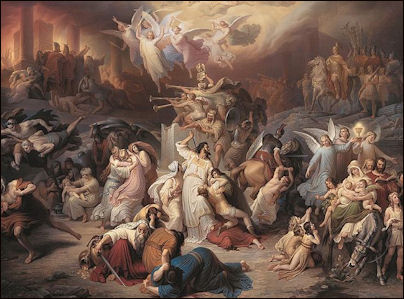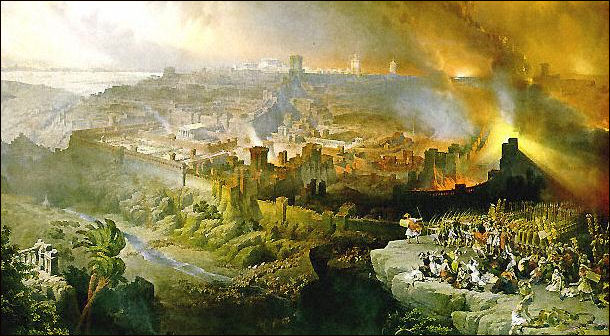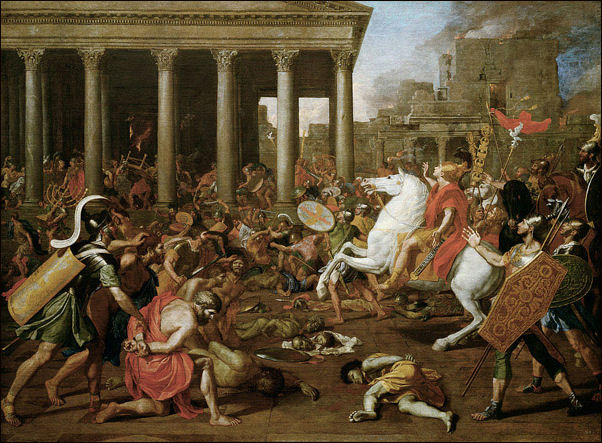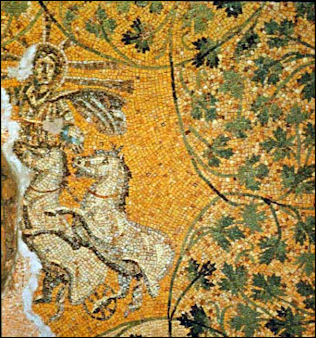JEWISH REVOLTS AND WARS

"destruction of Jerusalem's church"There were many uprisings by the Jews during the period of Roman rule. In the A.D. 1st century there were conflicts between the Essenes, the Pharisees and the Hellinized priests that ruled the Temple. Messianic fervor led to several uprisings that eventually forced the Romans to put down two major Jewish revolts, in A.D. 70 and A.D. 125, the destroy the Jewish Temple and disperse the Hebrew population. It has been suggested that if the Jews hadn't revolted there would have been no Jewish diaspora and history would have been very different.
In A.D. 64, Nero blamed the great fire of Rome on the Jews. Shortly afterwards there was a Jewish revolt that lasted from A.D. 66 to 73. Six Roman legions (35,000 men), Rome's most modern weaponry and siegecraft, and the leadership of two future Roman emperors to put down.
In A.D. 66, there was a Jewish revolt at Herod's Temple in Jerusalem. At that time bandit-guerrillas were at the height of their power and they were everywhere. A leader named Manahem took control of the temple area by driving out the Roman troops and executing the high priests. The same year there was also a major revolt in Caesara that led to the death of 20,000 people, nearly all of the Jews that lived in the city.
Nero dispatched Vespasian and a large Roman force to Judea (Israel) to put down the rebellion. Halfway through the war Nero was overthrown and Vespasian was proclaimed emperor by the Roman army. Nero died in A.D. 68, when the Jewish revolt had escalated. Vespasian didn't last long. He was succeeded by his son Titus.

"destruction of Jerusalem's church"There were many uprisings by the Jews during the period of Roman rule. In the A.D. 1st century there were conflicts between the Essenes, the Pharisees and the Hellinized priests that ruled the Temple. Messianic fervor led to several uprisings that eventually forced the Romans to put down two major Jewish revolts, in A.D. 70 and A.D. 125, the destroy the Jewish Temple and disperse the Hebrew population. It has been suggested that if the Jews hadn't revolted there would have been no Jewish diaspora and history would have been very different.
Siege of Jerusalem
Jerusalem was reclaimed by the Romans after a siege by Titus's army in A.D. 70. Describing what Jerusalem was like during the siege, Josephus wrote: "Throughout the city people were dying of hunger in large numbers and enduring indescribable sufferings. In every house the merest hint of food sparked violence, and close relatives fell to blows, snatching from one another the pitiful supports of life. No respect was paid even to the dying." [Source: Eyewitness to History, edited Jon Carey, Avon Books, 1987]
"Gaping with hunger, like mad dogs, lawless gangs went staggering and reeling through the streets, battering upon the doors like drunkards, and so bewildered they broke into the same house two or three times in an hour. Need drove the starving to gnaw at anything. Refuge which even animals would reject was collected and turned into food. In the end they were eating belts and shoes, and leather stripped off their shields. Tufts of withered grass were devoured, and sold in little bundles for four drachmas."

Siege and Destruction of Jerusalem
"Among the residents...was a woman called Mary...Famine gnawed at her vitals, and the fire of rage was even fiercer than famine. So, driven by fury and want, she committed a crime against nature. Seizing her child, and infant at the breast, she cried, 'My poor baby why should I keep you alive in this world or war and famine? Even if we live till the Romans come, they will make slaves of us...Come, be food for me."
"With these words she killed her son, roasted the body, swallowed half of it, and stored the rest in a safe place. But the rebels were on to her at once, smelling roast meat and threatening to kill her instantly if she did not produce it. She assured them she saved them a share, and revealed the remains of her child, Seized with horror and stupefaction, they stood paralyzed by the sight. But she said, 'This my own child, and my own handiwork. Eat, for I have already eaten."

Siege and Destruction of Jerusalem
Destruction of the Temple in Jerusalem in A.D. 70
In A.D. 70, Titus put down the revolt, captured Jerusalem, and punished rebellious Jewish zealots by salting agricultural land, slaughtered and enslaved thousands of Jews, and looted menorahs and other sacred objects. Thousands of Jewish slaves were brought to Rome from Judea. During a huge triumphal procession, commemorated by the Arch of Titus, Jewish prisoners were paraded through the streets and strangled at the Forum. Josephus claimed that all together over 1 million Jews died as a result of the Roman crackdown.
The Romans burned and sacked the Second Temple in Jerusalem. The Arch of Titus in Rome has a frieze showing legionnaires carrying candelabra and silver trumpets from the Temple. The Roman's added insult to injury by razing the Roman standard on the ruin of the Temple with an image of a pig (Jews like Muslims refrain from eating pork).

Destruction of the Jewish Temple by Nicolas Poussin
Jesus is said to have predicted the destruction of the Temple and that Titus would "leave not a stone unturned" as . Omens before 70 A.D., bright lights on the altar, a cow that gave birth to a lamb, chariots speeding through the sky at sunset.
Today the Western Wall (Wailing Wall) is all that remains visible today of the Second Jewish in Jerusalem . A retaining wall of a huge platform on which Herod's temple was built in 20 B.C. the Western Wall is about 60 feet high, 16 foot thick and composed of large blocks of stone (the largest of which are 30 feet long and weigh 50 tons) and is believed to have supported an esplanade. A 20 foot upper extension of the wall, made of smaller stones, is part of the ramparts of the Temple Mount, which belongs to the Muslims.
The Western Wall is just 55 meters long. An additional 325 meters runs underground, mostly in the Muslim Quarter of Jerusalem. Along side some sections are dimly-lit tunnels with vaulted ceilings, Roman columns and a musty smell. The stones in the walls are chiseled with an inset rectangular border, forming a perfect fit at the joints, A Jerusalem stone cutter told the U.S. News and World Report, “It's the most beautiful stone worker ever done in history. We can not do today what they did 2,000 years ago." The 13-meter-long, four-meter-high, 500-ton “huge stone” is used to stabilize the wall. Many building experts regard it as the largest building stone ever made. About 100 meters behind this area is where it is said the Ark of the Covenant was kept. Some think it still there.

Destruction of the Jewish Temple by Nicolas Poussin
Jesus and Christianity and Rome

Christ as the Sun in a Christian catacombAt the time of Christ, Palestine (present-day Israel) was a poorly-run, repressive Roman colony that had been conquered by Pompey in 63 B.C. After the conquest Palestine was run by a Roman-Jewish government under Herod the Great (37-4 B.C.) who enjoyed considerable autonomy and ruled in such a way that both the Romans and local population were reasonably happy despite his sometimes despotic ways.
The rulers after Herod---namely Archelaus, who inherited a third of Herod's land, including Judea and Jerusalem---were not so good. After 10 years Roman prefects took over Archelaus's territory. The other portions of Herod's former lands, including Jesus's state of Galilee remained under Jewish rule. This arrangement remained until the Roman crackdown after the Jewish revolt and the destruction of the Second Temple in A.D. 70.
Herod the Great was a Jewish leader installed by the Romans. Regarded as puppet king of the Roman Senate, he took power in 37 B.C. and ruled until around 4 B.C. and served under Julius Caesar, Mark Antony and the Emperor Augustus. He is remembered most for building the Great Temple for the Jews in Jerusalem and ordering the death of male children in Bethlehem after Jesus was born. His son Herod Antipas was involved in Jesus's trial. He was the ruler of Judea at time of the death of John the Baptist and Jesus.

Christ as the Sun in a Christian catacombAt the time of Christ, Palestine (present-day Israel) was a poorly-run, repressive Roman colony that had been conquered by Pompey in 63 B.C. After the conquest Palestine was run by a Roman-Jewish government under Herod the Great (37-4 B.C.) who enjoyed considerable autonomy and ruled in such a way that both the Romans and local population were reasonably happy despite his sometimes despotic ways.
No comments:
Post a Comment